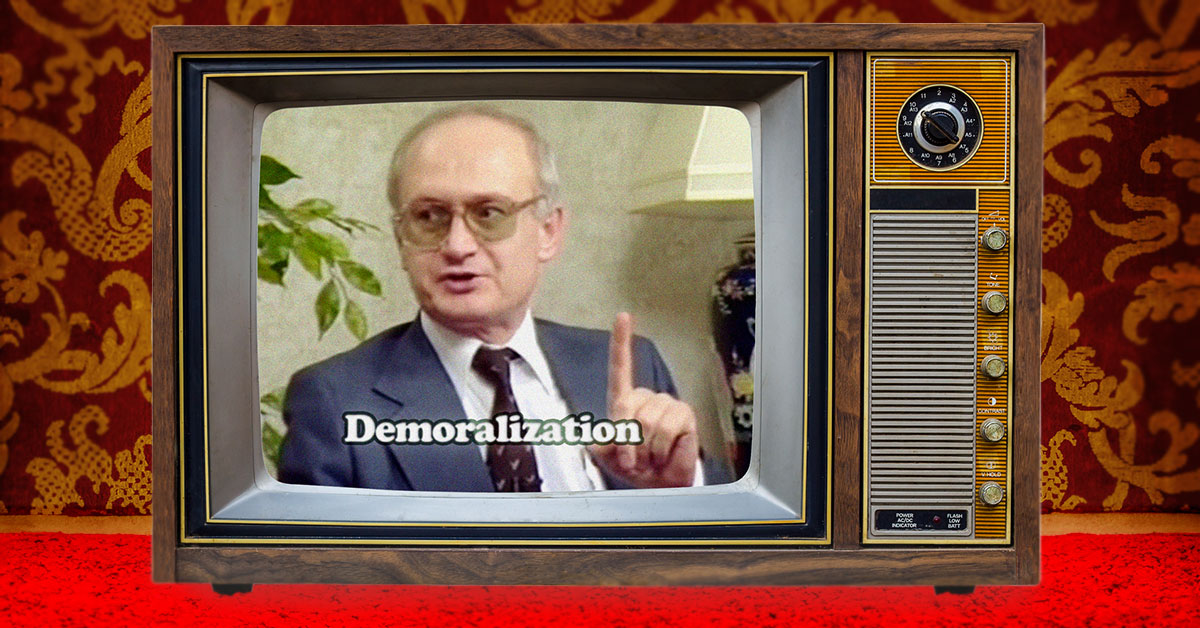Browse Categories
Add description, images, menus and links to your mega menu
A column with no settings can be used as a spacer
Link to your collections, sales and even external links
Add up to five columns
Add description, images, menus and links to your mega menu
A column with no settings can be used as a spacer
Link to your collections, sales and even external links
Add up to five columns
Spotting and Neutralizing Demoralization Campaigns
October 09, 2023 7 min read

Demoralization, a term often shrouded in the fog of psychological warfare, holds the power to undermine the very essence of human resilience, unity, and purpose. It's a calculated strategy employed in the realm of psychological and political warfare, with a singular aim – to erode the morale, willpower, and cohesion of a targeted group, organization, or population. These campaigns seek to weaken the resolve and effectiveness of the target without resorting to overt military or physical force. In this exploration, we'll not only delve into the purpose and mechanics of demoralization campaigns but also provide you with the tools to spot their subtle, yet impactful, signs.
The Purpose of Demoralization Campaigns
Demoralization campaigns are not mere acts of mischief; they are deliberate endeavors with a strategic purpose. Their primary goals include:
-
Undermining Trust: These campaigns seek to erode trust in key institutions like government, media, and the justice system. By sowing seeds of doubt and mistrust, they weaken the very pillars of society.
-
Exploiting Divisions: Division and polarization are their playgrounds. Whether it's political, ethnic, religious, or socioeconomic differences, they magnify existing fault lines to foster discord.
-
Creating Disarray: Through propaganda and disinformation, demoralization campaigns plunge society into confusion, sowing distrust and eroding confidence in leaders or institutions.
-
Inducing Fear and Anxiety: Amplifying real or perceived crises – be it economic downturns, public health emergencies, or security threats – they invoke fear and anxiety among the population.
-
Psychological Manipulation: Employing psychological manipulation techniques such as gaslighting, conspiracy theories, and emotionally charged language to breed confusion, frustration, and powerlessness among the target audience.
Signs of Demoralization
Recognizing the signs of demoralization is pivotal in safeguarding a society's collective spirit. Keep a vigilant eye out for:
-
Widespread Distrust: A pervasive lack of trust in institutions and authorities, coupled with a sense of disillusionment.
-
Elevated Polarization: Exaggerated divisions and hostility among different groups within society.
-
Disinformation Overload: The rapid spread of false or misleading information, often leading to confusion and conflicting beliefs.
-
Emotional Drain: A palpable sense of despair, hopelessness, or anxiety among individuals.
-
Isolation and Alienation: The marginalization of individuals or groups resisting the campaign's influence.
-
Diminished Leadership: Leaders and figures of authority opposing the campaign's objectives facing character attacks and harassment.
The Origins and Historical Examples
The tactics employed in demoralization campaigns have been honed through history. Three notable historical examples include:
-
Cold War Psychological Operations: During the Cold War, both superpowers, the United States and the Soviet Union, utilized psychological operations, including demoralization tactics, to weaken each other's global influence.
-
Propaganda in World War II: Propaganda campaigns, such as the Nazi regime's dissemination of anti-Semitic material, aimed to demoralize not only the Jewish population but also the broader society.
-
Vietnam War PsyOps: Psychological operations played a significant role in the Vietnam War, where both sides employed tactics to influence the morale and support of the opposing forces and populations.
As we navigate the complexities of demoralization campaigns, remember that knowledge is your shield. Armed with understanding, vigilance, and a commitment to the values of liberty and unity, we can stand resilient against these subversive strategies.
So, how exactly does a demoralization campaign operate? Strap in, because we're about to unveil their playbook:
1. Propaganda and Disinformation: The first weapon in their arsenal is the spread of falsehoods and misinformation through various channels – from social media to news outlets. Their goal? To create chaos, breed mistrust, and shake your faith in leaders and institutions.
2. Exploiting Divisions: These campaigns thrive on existing divisions – be it political, ethnic, religious, or socioeconomic. They'll fan the flames of discord, turning differences into deep-seated rifts.
3. Undermining Trust: They're out to erode your trust in essential institutions like government, media, and the justice system. By doing so, they weaken the very foundations of society.
4. Crisis Amplification: Real or perceived crises become their ammunition. They blow them out of proportion, stoking fear and anxiety in the hearts of the people.
5. Psychological Manipulation: Prepare for gaslighting, conspiracy theories, and emotional manipulation. Their aim? To leave you feeling confused, frustrated, and powerless.
6. Isolation and Alienation: Those who resist their influence may find themselves isolated and marginalized – cut off from the mainstream.
7. Diminishing Leadership: Leaders opposing their goals aren't spared. They subject them to character assassination, harassment, and public humiliation to weaken their influence.
8. Persistent Messaging: These campaigns play the long game, wearing you down with a constant barrage of negative narratives until you feel fatigued and resigned.
9. Reinforcement of Pessimism: Brace yourself for a steady stream of pessimism. They want you to believe that your efforts for change are futile.
10. External Support: In some cases, external entities may lend a hand, funding, or guidance to these campaigns. Their goal? To exploit internal divisions and weaknesses.
Now, here's the deal – the effectiveness of these demoralization campaigns varies, but there's hope. By staying vigilant, evaluating information sources critically, and arming yourself with accurate information and a resilient spirit, you can stand strong against these tactics.
Evolution of Demoralization Tactics: The Intersection of Radical Leftist Activism and Traditional Strategies
The landscape of demoralization tactics has witnessed a profound transformation in recent decades. With the advent of radical leftist activism techniques, rooted in works like Saul D. Alinsky's "Rules for Radicals," and their adoption by influential figures from the Baby Boomer generation, including the likes of Barack Obama, traditional demoralization strategies have taken on a new, formidable shape.
A Fusion of Ideologies
Saul D. Alinsky's "Rules for Radicals" introduced a playbook for grassroots activism that emphasized tactics like community organizing, agitation, and the mobilization of marginalized groups. These principles, rooted in radical leftist ideology, have found fertile ground in contemporary demoralization campaigns.
Community Organizing as a Demoralization Tactic
One notable intersection between Alinsky's teachings and traditional demoralization strategies lies in community organizing. The art of uniting diverse, often marginalized groups to challenge the status quo has been adopted not only as a tool for positive change but also as a means of sowing discord and discontent within society.
Agitation and Polarization
Alinsky's emphasis on agitation as a means of mobilizing communities has been harnessed in a manner that amplifies divisions within society. The deliberate stoking of polarizing issues, often exacerbated by sensationalized media coverage, serves to weaken societal cohesion and amplify the demoralization effect.
The Influence of Key Figures
Leaders like Barack Obama, shaped by the ethos of their generation, have applied Alinsky's principles to their political strategies. Obama's background in community organizing and his charismatic communication skills allowed him to tap into the power of grassroots movements, simultaneously inspiring and dividing the nation.
Modern Platforms and Social Media
The advent of modern communication platforms, particularly social media, has provided an unprecedented platform for the rapid dissemination of disinformation, propaganda, and emotionally charged narratives – all in line with demoralization objectives.
The Ongoing Battle
As demoralization campaigns continue to evolve with the infusion of radical leftist activism techniques, the need for vigilance and discernment becomes ever more critical. Recognizing the intersection of these ideologies and their impact on public discourse empowers individuals to navigate the complex web of information and counteract the effects of demoralization.
In this era of information warfare, the tools of awareness, critical thinking, and unity remain our most potent defense against the demoralization tactics that seek to weaken the foundations of liberty, resilience, and unity. By understanding the evolving strategies and their historical context, we can fortify our resolve and stand resilient against the winds of division and discord.
Sustaining Morale: The Pillars of Strength Against Demoralization
The delicate dance of morale maintenance can be tricky but not impossible. The secret sauce is strong leadership. It's the ultimate demoralization repellent.
Morale crumbles when people think they're victims of injustice. This is especially the case when the believe the system is fundamentally unfair. Motivation diminishes because it seems like a waste of time to challenge a system that is rigged to begin with. Even worse, if people sense indifference from leadership, action seems even more hopeless. Equally devastating is the notion that leadership might be clueless or in it for their own gain.
But good leadership and organization principles can make any group or movement immune to demoralization. In effect, there is a morale-saving playbook, and it's dependent effective leadership qualities.
1. The Fear Factor: When members of the group fear their own leadership more than the enemy typically are less affected by demoralization. This fear can take on various forms, from a more authoritarian type to a democratic one, where members fear letting down their cause by not contributing effectively. In the military, it's often as simple as fighting for the guy next to you.
2. The Love Language: When group members feel genuinely appreciated by their leadership, they're much harder to demoralize. It's a basic human truth that people perform at their best when they know their efforts are valued. Those who feel appreciated are willing to go to extraordinary lengths, even making sacrifices.
3. The VIP Feeling: If a member's contributions hold significance to the other members of the group and to the overall success of the effort, this alone can counteract demoralization. It's all about leaders inspiring hope to make them feel their hard work adds up to success and is important. But if leadership isn't judicious with its inspiration and is excessively trying to inspire the group, it can backfire quickly by seeming ingenuine. This devolves quickly into group cynicism.
4. Team Spirit: Genuine loyalty and camaraderie is like demoralization kryptonite. High morale can thrive even in the most challenging circumstances, driven by a shared desire to avoid disappointing or endangering their comrades. Nobody wants to let down their buddies, right?
5. Faith & Credibility: Faith in leadership and a belief that success is possible is a key to healthy morale. When trust and faith in leadership fade away, people begin abandoning the effort. But when the members of the group have faith that leadership is at least as dedicated to the success of the group as they are to leadership morale doesn't become an issue.
1 Response
Leave a comment
Also in Liberty Maniacs News

Enemies of Satire: How Liberty Maniacs Survived Censors, Lawsuits, and the Joke Police
May 01, 2025 3 min read
True tales of the most powerful agencies, politicians, and brands who tried to censor our jokes—and what happened when we fought back.

You’re Not a Nazi. They Just Want You to Shut Up.
March 28, 2025 7 min read
They call you a Nazi so you’ll sit down and shut up—but the man who actually escaped them would say you’re nothing of the sort.

10+ Ways USAID Burns Your Tax Dollars on Pure Insanity
February 19, 2025 4 min read
USAID: where your tax dollars fund transgender operas, Taliban poppy fields, and luxury hotels for migrants—because actual humanitarian aid is so last century.
Recent Articles
- Enemies of Satire: How Liberty Maniacs Survived Censors, Lawsuits, and the Joke Police
- You’re Not a Nazi. They Just Want You to Shut Up.
- 10+ Ways USAID Burns Your Tax Dollars on Pure Insanity
- Trump’s Day-One War on the Government-Censorship Hydra
- The Ultimate Guide to Men's Clothing Sizing
- The Ideological Capture Behind the Woke Left's Meltdown Over Trump's 2024 Victory
- The Yuri Bezmenov Playbook: A Guide to Ideological Subversion
- 198 METHODS OF NONVIOLENT POLITICAL ACTION
- Why the 2nd Amendment is Awesome
- I Have A Nightmare
Sections You Might Like
Subscribe
Sign up to get the latest on sales, new releases and more …








Cornell Slaton
May 16, 2024
Helpful